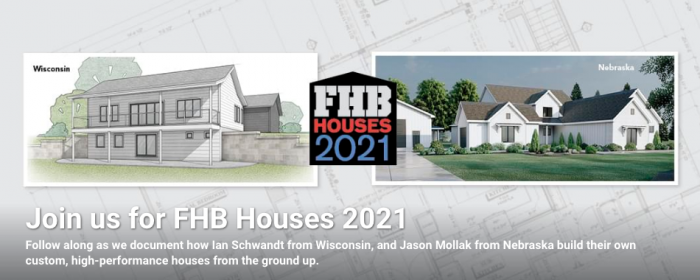Podcast 354: Nasty Crawlspaces, Concrete Houses, and Your First Employee
Patrick, Kiley, and Rob hear from listeners about DIY insulation vacs and AV gas for generators before taking questions on nasty crawlspaces, polished concrete floors, and hiring your first employee.
Follow the Fine Homebuilding Podcast on your favorite app. Subscribe now and don’t miss an episode:
 |
 |
Help us make better episodes and enter for a chance to win an FHB Podcast T-shirt:
www.finehomebuilding.com/podcastsurvey
Jim asks for the identity of Dana’s energy integrator. Mike sent video of his DIY insulation vac. Tom tells us about a new way to think about safety. Derek gets us talking about generator fuel again. Steve asks about the best way to insulate his basement crawlspace. Jay asks if you can have concrete floors on top of wood framing. Mitch wonders when he should hire his first employee.
Editor Updates:
- Rob’s hot tub electrical
- Kiley’s real estate
- Patrick’s new shop shelves
 |
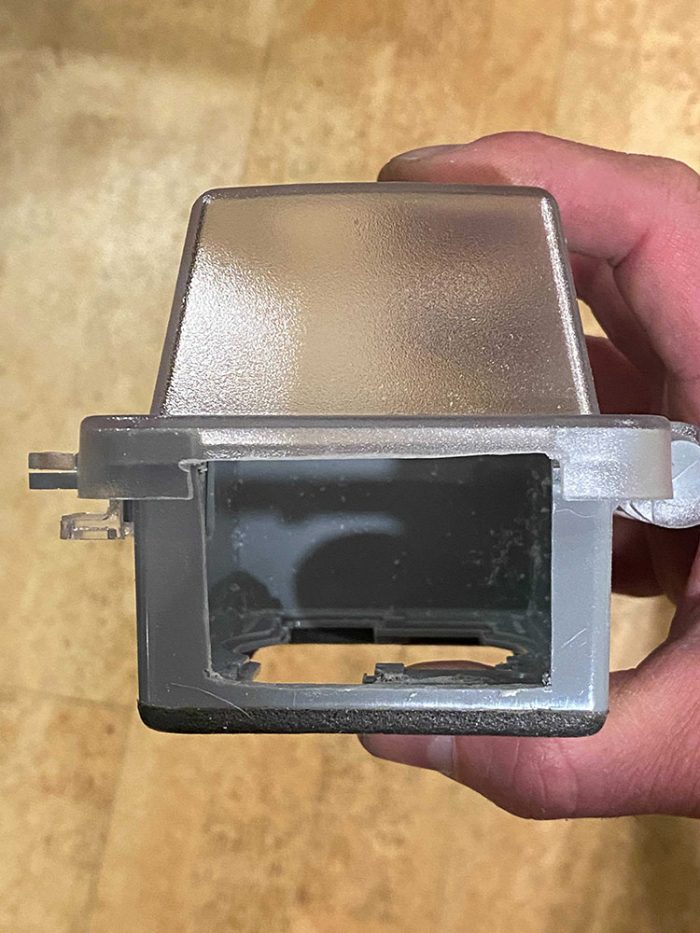 |
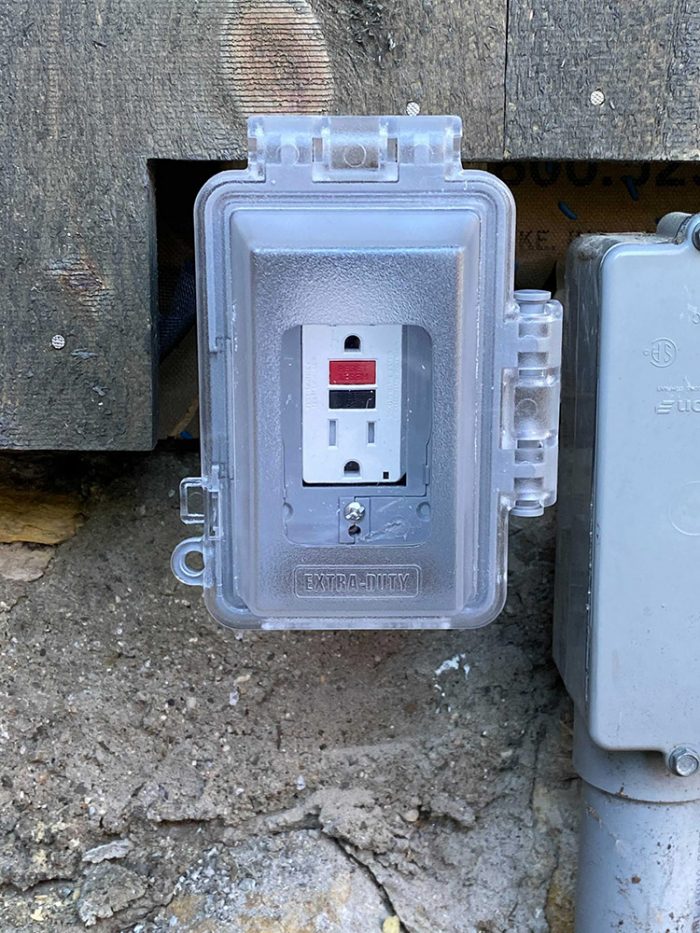 |
Related Links:
- www.insulatedpoolkits.com
- Everett Wrightson-Kramer’s concrete plunge pool
- SaluSpa Honolulu inflatable hot tub
Listener Feedback 1:
Jim from Saratoga Springs, NY writes: Hi Matt, Kiley & Patrick, love your podcasts. In #346, Listener Feedback from Dana was discussing the difficulty in finding an Energy Integrator for a new home build. After much effort, “Ultimately, I did find someone who performs all of that design work for custom home builds. He’s preparing a bid for our project. He has great references and comes very highly recommended. I just wish we had more experts to choose from. This guy is one in a million.” But Dana left us hanging and never told us who it is or provide a reference. If Dana provided it to you separately, could you share it with the FH community? Thanks in advance.
Hans writes: Hi Dana, I am certainly fine with having you talk or write about me and our approach. I am as much an educator as I am an integrator, mechanical designer, and building science consultant, and I agree that there need to be more “of me”. It’s rare that building professionals take the time to explain things in great detail, except on reputable platforms like “Fine Homebuilding” and the “Green Building Advisor” where I have been a subscriber (GBA.com) for years because I need to educate myself sometimes or I need a 2nd opinion/reality check. Chances are someone else has had the same problem before me and if I am lucky even written about it. I guess it’s urgent that I get my web site up and running!
Cheers,
Hans Joachim Preiss
Principal | BrightSense LLC
Net-zero Energy Building Solutions
Listener Feedback 2:
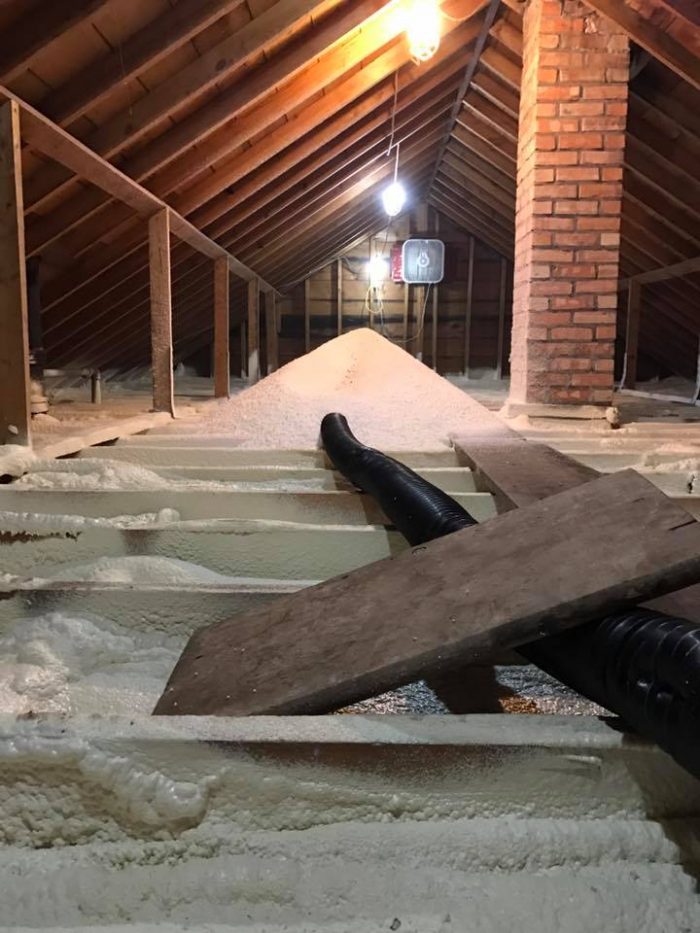
• For a blower/vacuum, I used a 2hp dust collector from Harbor Freight. I replaced the top fabric bag with plastic to force more airflow through the bags. The screen over the inlet needed to be removed. I only locked up the motor a few times with a stray chunk of wood.
• Bags were created by rolling and duct taping poly into a tube, then covering one end with insulation fabric to allow for airflow. They ended up being 3′ diameter and 10′ long. These attached to the lower section of the dust collector using the factory band clamp.
• Tubing was corrugated drain tile called Flex-drain. The frictional losses were horrendous, but surprisingly it rarely plugged. Some minor adaptor work fit it to the inlet of the vacuum.
Vacuuming the styrofoam was just walking like an elephant swinging its trunk to pickup peanuts. The rockwool was a bit more work. It wasn’t loose fill but they weren’t quite batts either, so I had to paw at it to break chunks off and direct them to the hose end.
I gave away the rockwool, but blew the styrofoam back in by reversing the inlet/outlet hoses. I created a wire cage to keep the hose off the plastic, it took little time to empty a bag. After selling the dust collector I had maybe $200 into the project and was able to work on my own time schedule.
Thanks for the motivation, laughs and information!
Related Links:
Listener Feedback 3:
Tom writes: Hello FHB podcast, In Episode 342 you read a letter from a listener about applying nuclear industry safety ideas to the jobsite. You might be interested to know that there’s an alternate approach to safety that’s developed over the past dozen or so years, based around principles of human and organizational performance. It doesn’t look at workers as a problem to be solved, but considers workers the problem solvers. It abandons the idea that “all accidents are preventable” and instead considers safety to be not the absence of accidents, but the presence of capacity to respond to adverse conditions. Does a worker make a bad choice, or does a worker have bad choices? Can we ask what failed, instead of who failed?
Dr. Todd Conklin—formerly of Los Alamos National Laboratory—gives a fantastic introduction to this new view of safety in this presentation to a group of steelworkers (https://youtu.be/IoYUQlWiRgc).
Most of Conklin’s focus is on high-risk organizations, like manufacturing and petroleum, and would need some amount of translation to be applicable to the residential construction workplace. But with the frequent discussions of workplace safety on the FHB podcast, I thought you’d find this as interesting as I have. (And there’s much more—Conklin has a podcast, he’s written several books, there are a number of others doing similar work.)
Related Links:
Listener Feedback 4:
Derek writes: Hello esteemed FHB Podcasters, Hearing your tales of regimented routines for the exchange of degraded fuel from one machine to another to prevent engine damage, wore me out and made me think there has to be a better way to spend your summers there out East. 🙂 Living in California and regularly using portable generators for both remote worksites and to subsidize our local utility grid (PG&E) for winter and summer outages, the subject of which fuel to use for long term storage between these events is a frequent topic for discussion. The collective answer is… jet fuel. If you have a County airport nearby, there is typically a self-service pump available where you can dispense aviation fuel into a portable can at a cost that is not much higher than standard gasoline, but absent the additives and thinners that can degrade to leave you with a tank full of varnish faster than you can say “Public Safety Power Shutoff”. The old timers will tell you that this fuel lasts forever, Google says slightly less than forever, but anecdotally the local generator repair shops recommend it to their customers and the fact that my generator always starts on the first pull is one more for the plus column, but then again it is a Honda. Love your show and keep up the craft.
Patrick adds, not really jet fuel, but AVgas.
Avgas (aviation gasoline) is used by small aircraft, light helicopters and vintage piston-engined aircraft. Its formulation is distinct from the conventional gasoline used in motor vehicles which is commonly called mogas or autogas in aviation context. Although it comes in many different grades, its 100 octane rating is higher than that for “regular” motor gasoline which varies between 91 in the United States and 95 in Europe. Avgas is the only remaining lead-containing transportation fuel. Lead in avgas prevents damaging engine knock, or detonation, that can result in a sudden engine failure.
Question 1: What approach do I take to insulate and air-seal my ad-hoc floor system without doing serious excavating?
Steve in northern coastal Mass. writes: Greetings FHB podcasters. I’ve been a listener since episode 1. I’m hoping you can offer some advice on a new project. I’ve recently sold my previous home and purchased a 1960’s Cape here in northern coastal Massachusetts. The original home has a poured concrete foundation, but a 25’x15′ addition that was added sometime in the 1990’s (I’m guessing…) has no basement. The main part of the addition is supported by concrete block piers supporting 2×8 floor joists, but the joists at the extreme front and back of the space (which I suspect were at some point outside porch decks) sit on 4×4 posts supported by 10″ concrete sono-tube footings. This room is drafty and the floor is cold.
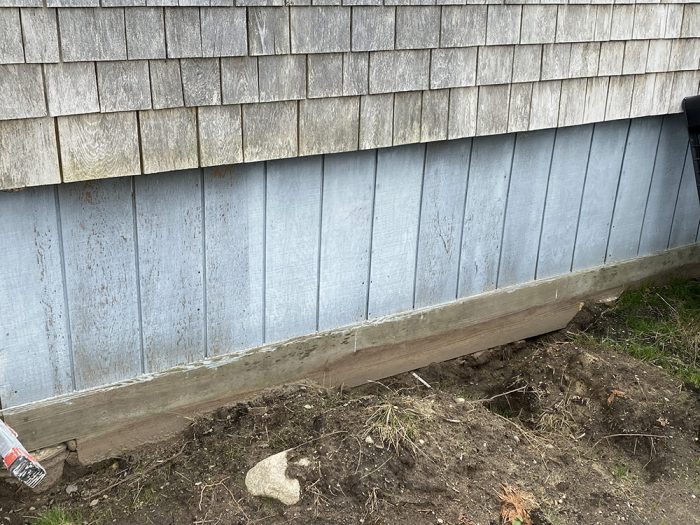 |
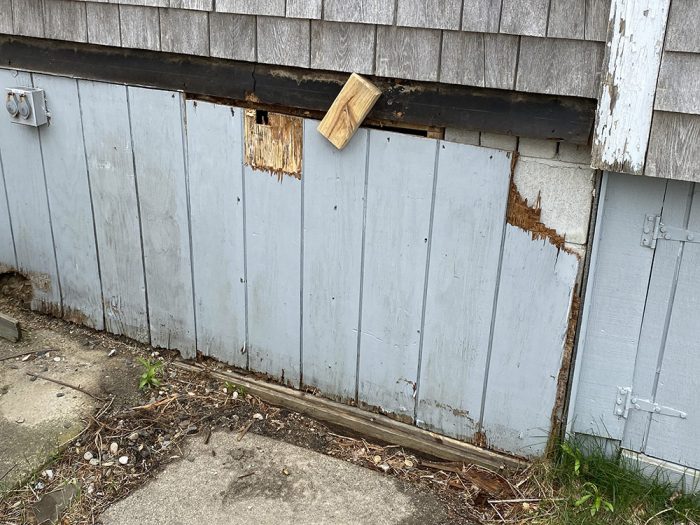 |
 |
 |
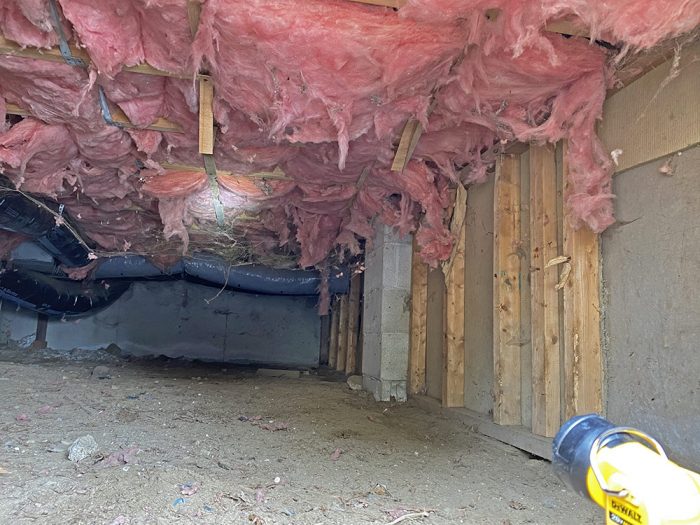 |
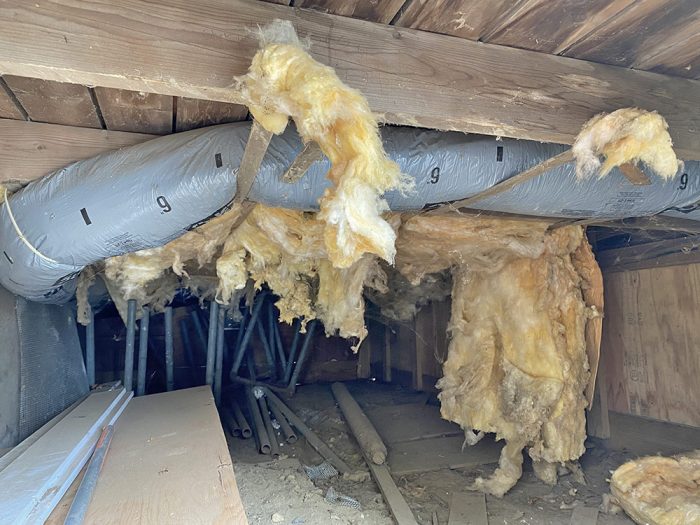 |
The addition has some shoddily built, 3′ tall ‘skirt’ walls between the floor platform and the ground, made of 2×4’s and T-111 sheathing. But there’s no chance of making those walls airtight to create a sealed crawlspace without doing some serious excavating and constructing some real foundation walls. So it’s essentially an open platform with some fiberglass insulation applied to the underside, between the joists. That fiberglass is mostly useless, as with no supporting layer beneath it, much of it has fallen away from the floor sheathing over the years, and the space is now being leased out as “Luxury Condos” by the local Mousing Authority.
So, my question: What approach do I take to insulate and air-seal this floor system? I’ve done a bit of research, but all of the articles on crawlspaces seem to assume that there are concrete walls, and that the space can be tightly sealed. This space definitely cannot be — or at least, not without some serious foundation work.
My idea is to replace the old insulation with 8″ of mineral wool, then apply a 2″ layer of foam insulation to the underside of the joists, sealing that foam layer’s joints with spray foam to create an air sealing layer. Is this approach reasonable? Do I need to apply another fireproofing layer under the foam, or can I just leave that exposed to the ground below? XPS, EPS, or PolyIso? And should I try to apply a layer of 6 mil polyethylene sheeting along the ground, and maybe run it up the inside of those skirt walls (which will be rebuilt…) and somehow tie that sheet into the foam layer, to help eliminate any ground vapor? Any advice on better approaches, or critiques of my intended approach above?
Related Links:
Question 2: What ideas and thoughts do you have for pouring concrete on above-grade, framed floors?
Jay writes: What details, considerations, ideas and thoughts for you guys have on pouring concrete on above grade framed floors? I was planning on doing 2.5″ slabs on top of sealed sub floor and having half inch radiant heat in it. Then polishing the surface to be final floor.
Related Links:
Question 3: What are your thoughts on building more concrete homes to withstand weather events?
Bryan from Huntsville, Alabama writes: Discussion about building costs has been a topic over the last year due to the pandemic. I never hear any conversation about concrete homes and would like your thoughts. There is one company in Houston, Texas—Eco Cast Homes. They can put a shell of a home to include concrete roof up in 2 days and have it move in ready in 60 days. Foundation and site prep may not be included in these time estimates. I called the company and in discussion the rough shell with foundation and plumbing I believe was around $70 sq ft.
Concrete seems like a great building alternative for so many reasons. Efficiency and strength of the system when produced in a controlled environment is one. Another is the fire and storm resistance that I would like to have being a resident of the south.
There does not seem to be a lot of precast concrete home builders out there. Eco Cast and Superior Walls are a few but for some reason this is not a viable or likeable option for many and that is why I presume there are so few. There was a home that was being advertised a while back called the Forever home that up and just disappeared from the market. I think homes like this would be preferred for coastal environments yet it seems wood is still preferred to protect all your life’s possessions in hurricane force winds.
Hope to get your thoughts and appreciate your podcast.
Related Links:
- Hillside Center For Sustainable Living
- A Holistic Approach to Housing
- Designs Northwest Architects “Tsunami House”
- Built For Catastrophe
Question 4: When is a good time to hire full-time employees for my growing remodeling business?
Mitch writes: Hey Fine HomeBuilding Podcast! Big fan. I am a young remodeling contractor out of Boise, Idaho and I am thinking about taking a big step in the future of my company, despite what many of my older mentors are advising me to do. Like every other contractor who returns phone calls in Boise, I have more work on my hands than I can handle and without the help of some other like-minded friends with their own single-man companies, I would be completely overwhelmed. So… I am looking to you guys for guidance.
When do you think is the right time to hire on full-time employees? It seems to make sense to me to start building sooner than later, yet the past builders that I have worked under are telling me the same thing, “wait as long as you can before you hire anyone.” Even my insurance agent toots that horn. Then, those same people are telling me how hard it is to find good help. If I’ve got good people now… doesn’t it make sense to lock them in and start building together as one company? Other than the additional paperwork, insurance, and workers comp expenses what do you guys think are additional deterrents for joining forces?
I feel like my company is going through its formidable pubescent years, I’m chomping at the bit to take on more work and employees, while also trying to understand that it’s been all roses and rainbows to this point, and we have never had to try to stay afloat while keeping an economic downturn at bay. It’s a confusing and exciting time. I am a big fan of Shawn Van Dyke and would love to hear him on your podcast again, also Tim Uhler is my hero. Thanks for being my construction dads, because of you guys, I will not walk the parade of homes until our production builders stop toting a HERS rating of 70.
Related Links:
- How to Grow a Construction Business
- Calculating the Labor Burden for Your Construction Business
- Self Taught MBA: New Recruits: The Art of Hiring Right
End Notes:
Check out our new 2021 FHB Houses:
Visit the Taunton Store • Magazine Index • Online Archive • Our First Issues • All Access
Help us make better episodes and enter for a chance to win an FHB Podcast T-shirt: www.finehomebuilding.com/podcastsurvey

If you have any questions you would like us to dig into for a future show, shoot an email our way: [email protected].
If we use your question we’ll send you a FHB Podcast sticker!
FHB Podcast T-shirts!
Represent your favorite podcast! Available in several styles and colors. Made from 100% cotton. Find the Podcast t-shirt and more cool products in the Fine Homebuilding Store.
This episode of the Fine Homebuilding podcast is brought to you by BUILDBOOK.
A lot of construction pros have a common problem; your construction management software is either non-existent, or it is too slow and too complex. It shouldn’t be bogged down with complicated features that you have to attend an academy to learn how to use. You need software you can start using DAY ONE without training… That is faster and more reliable than your notepad. That allows you, your team and your clients to always know what’s getting done and when. And your software should reduce stress, not increase it. The solution? BuildBook.
BuildBook is built for today’s modern builder with everything you need, nothing you don’t. Whether you’re a one man operation or a business with a large crew, BuildBook has plans to fit your budget. No nagging sales calls, tricky upsells or hidden fees. Head over to BuildBook.co and sign up for a free 10-day trial — and don’t forget to mention that you heard about them on the Fine Homebuilding podcast.
Fine Homebuilding podcast listeners can now get 20% off anything in the Taunton store, including Insulate & Weatherize.
Use the discount code FHBPODCAST to take advantage of this special offer.
We hope you will take advantage of a great offer for our podcast listeners: A special 20% off the discounted rate to subscribe to the Fine Homebuilding print magazine. That link goes to finehomebuilding.com/podoffer.
The show is driven by our listeners, so please subscribe and rate us on iTunes or Google Play, and if you have any questions you would like us to dig into for a future show, shoot an email our way: [email protected]. Also, be sure to follow Fine Homebuilding on Instagram, and “like” us on Facebook. Note that you can watch the show above, or on YouTube at the Fine Homebuilding YouTube Channel.
The Fine Homebuilding Podcast embodies Fine Homebuilding magazine’s commitment to the preservation of craftsmanship and the advancement of home performance in residential construction. The show is an informal but vigorous conversation about the techniques and principles that allow listeners to master their design and building challenges.
Other related links
-
- All FHB podcast show notes: FineHomebuilding.com/podcast.
- #KeepCraftAlive T-shirts and hats support scholarships for building trades students. So order some gear at KeepCraftAlive.org.
- The direct link to the online store is here.
